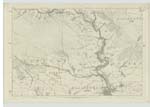OS1/25/42/14
| List of names as written | Various modes of spelling | Authorities for spelling | Situation | Description remarks |
|---|---|---|---|---|
| Supposed Site of the BATTLE OF MONS GRAMPUIS (Continued) | 052 | [continued from page 13] towards the north; and accordingly you may trace throughout its whole length, a rampart (in some places still 20 feet broad and 5 feet high,) extending in a straight line from the Isla to the old course of the Tay. the Praetorium too, is quite distinct, and runs no risk of being degraded, like the "Kaim of Kinprunes", into a base "bit bourock" by any wandering gaberlunzie man. In short, there is not a shadow of doubt regarding the authenticity of the Camp. So far all is satisfactory and we must now look about us for the Caledonian Camp, nor shall we search in vain: we can point it out to you without moving a step. Cast your eyes in a North-Westerly (from Craig Roman) direction to a point on the north of the Lornty Burn, where you perceive a few scattered firs, the remains of a patch of wood now nearly all hewn; a little beyond the trees, you will observe what seems at this distance a common "feal dike", but which is in fact, an earthen rampart, some 8 feet high, forming three sides of an oblong, resting on the acclivity, and descending into the hollow through which the burn flows. The rampart crosses the hollow and completes the oblong on the top of the south bank of the burn, enclosing a space of a square mile, the place is called the "Buzzard Dykes" or Garry Drums"- names the etymology of which has fairly baffled us; they are probably corruptions of original Celtic appelations. There is however no room to doubt of its having been a Native Camp, fortified in rude imitation of the exact and regular entrenched camp of the invading foe. The two camps being thus ascertained, let us now see what traces exist of the actual Battle. Of these, there is certainly no lack. Along the whole extent of that barren heath which skirts the south side of the Lornty Burn, as far west as Benachally, are scattered numerous Cairns or tumuli, and the same remains are found in great numbers throughout the district of the Stormont, as the local names attest - Although the progress of agricultural improvements has removed all traces of them from the more level parts of the district, "Upper Balcairn", "Nether Balcairn", Cairnbutts" are names of places a little to the north-west of Marlees. "Kincairney, Nether Kincairney & Cairnmuir" lie in the valley farther south. On the heights to the North-east of Craig Roman, near the Ericht are the great "Cairns of Maws" one of which was opened some time ago, and a quantity of human bones, mixed with charcoal found in it. Early in the last century there was dug out of a Moss in the neighbourhood of Maws, the remains of a Roman Soldier in complete Armour, the skeleton was found in an upright position; and it is supposed that he had been drowned in attempting to cross the marsh, either in flight or pursuit. We have ourselves have seen the bronze head of a Roman battle-axe which was dug out of the same moss; and another of these weapons was found on the muir to the south of the Caledonian Camp already mentioned, pretty strong indications these of a "foughten field" we presume to opine. But we must not omit to call your attention, most particularly, to the fact, that our theory places the field of battle literally at the "Grampian Hills" and is therefore, perfectly in accordance with the account Tacitus in the only local particular he mentions. The Caledonians are supposed to have occupied a position on the long hilly ridges to the north and west of Blairgowrie of which Craig Roman is the first towards the valley; and these ridges form the skirts of the first chains of the Grampians. The country to the north-west was covered with wood, forming the ancient forest of Cluny (by which name the district is still known) into whose recesses, doubtless the defeated Caledonians retreated as narrated by Tacitus, their left was covered by the Ericht, their right by a deep ravine descending to the west of Cluny, - and in front was the Lunan Burn, and the chain of Lochs, which we have already pointed out and described. Nothing could have been better chosen than this strong position for receiving the attack of the Roman Army; and it also completely covered and blocked up the only pass by which the invaders could pentrate in that direction farther into the heart of the Country. We leave it to your imagination to trace the probable dispositions of the Roman General in his advance from the Camp at Meiklour to attack this formidable position. Nor shall we attempt a description of the battle itself of the regular and disciplined columns of the Roman infantry, with their flaunting lancers and glittering armour, advancing steadily on their fierce but unskilful and ill armed foe. their cavalry manouvering on both wings across the plain - the headlong charge of the Caledonians, with their huge swords and small bucklers, as they rush down the hill from their strong position to meet their hated invaders. the Armed Chariots (coornarii) careering across the plain, carrying confusion and terror into the Roman ranks while [continued on page 15] |
Continued entries/extra info
[Page] 14.
Transcribers who have contributed to this page.
Alison James- Moderator, Brenda Pollock
Location information for this page.
Linked mapsheets.




